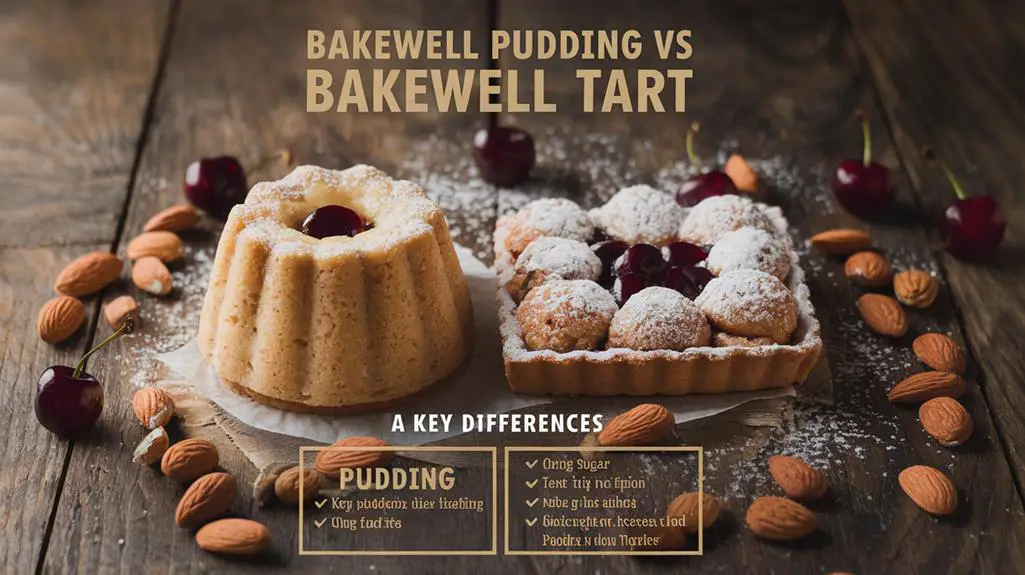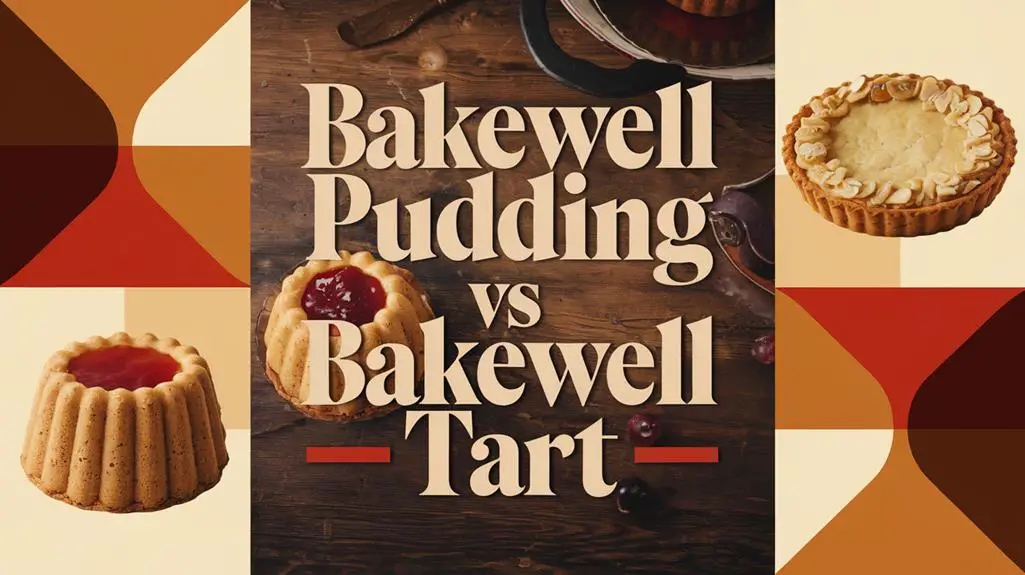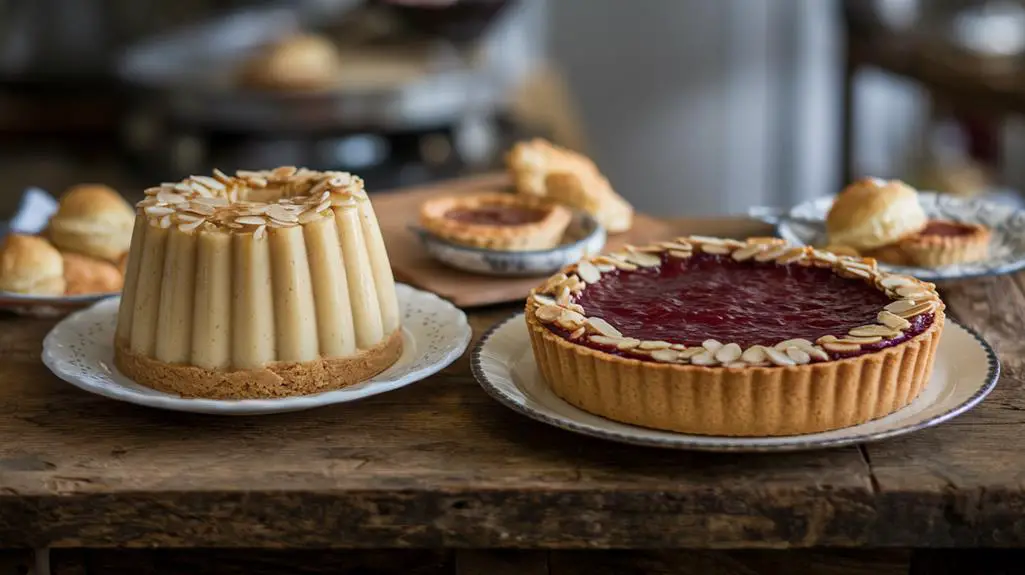In exploring the distinctions between Bakewell Pudding and Bakewell Tart, one uncovers a fascinating interplay of ingredients and history that sets these two desserts apart. For instance, the pudding's flaky puff pastry contrasts sharply with the tart's denser shortcrust base, hinting at deeper culinary narratives. Furthermore, the variations in sweetness and texture invite further examination into their respective origins and cultural significance. As one considers these elements, it becomes evident that each dessert offers a unique experience, prompting a closer look at the remaining key differences that define them.
Quick Takeaways
- Bakewell Pudding features a flaky puff pastry base, while Bakewell Tart has a denser shortcrust pastry base.
- The pudding is topped with a soft set almond custard, whereas the tart includes a sponge-like frangipane layer.
- Bakewell Pudding is generally sweeter than the tart, highlighting its richer custard composition.
- The pudding's historical origins trace back to the 1860s, while the tart emerged later as a variant.
- Serving suggestions differ, with pudding best served warm and tart enjoyable at room temperature.
Definition and Composition
When it comes to the delightful world of British desserts, Bakewell Pudding and Bakewell Tart stand out not just in flavor but in their distinct compositions.
Bakewell Pudding features a buttery puff pastry base that creates a flaky and rich texture. It's generously topped with a layer of seedless strawberry jam and a soft set custard made from eggs, sugar, and almonds, resulting in a dessert that's generally sweeter than its tart counterpart.
In contrast, Bakewell Tart is crafted with a traditional shortcrust pastry base, lending it a denser, crumbly texture. This dessert layers strawberry jam beneath a sponge-like frangipane mixture, which is often adorned with sliced almonds for added crunch and visual appeal.
The tart's combination of the shortcrust pastry and frangipane gives it a delightful balance of flavors, but lacks the custard-like richness found in Bakewell Pudding.
While both desserts share the common flavor of strawberry jam, their unique compositions and textures set them apart, making them beloved choices for any dessert enthusiast looking to serve something special.
Historical Origins
The historical origins of Bakewell Pudding and Bakewell Tart weave a fascinating narrative that reflects the culinary evolution of English desserts.
Bakewell Pudding, believed to have been accidentally created in the 1860s by Mrs. Greaves at the White Horse Inn, emerged from a recipe misunderstanding. Instead of mixing the custard with jam, she poured it over, resulting in a delightful confection that would soon captivate taste buds. The first known recipe for this pudding appeared in 1845, credited to Eliza Acton, though the true origins often spark debate.
In contrast, the Bakewell Tart surfaced later as a variant, showcasing a shortcrust pastry base topped with a rich frangipane sponge, which distinguishes it from the original pudding.
While historical accounts hint at the pudding's roots tracing back to medieval times, concrete evidence remains elusive. Both desserts proudly hail from Bakewell, Derbyshire, a town that has solidified its culinary heritage through these beloved specialties.
Today, they represent not just a treat, but a reflection of the rich tapestry of English gastronomy, inviting everyone to celebrate their delicious legacy.
Culinary Significance

Both Bakewell Pudding and Bakewell Tart hold a special place in the culinary landscape of the UK, each contributing uniquely to the region's gastronomic identity.
The Bakewell Pudding, with its buttery puff pastry base, rich almond custard, and sweet strawberry jam, showcases a decadent side of Bakewell's culinary heritage. Its traditional recipe has made it a celebrated dessert, often hailed as a key culinary export from Derbyshire.
In contrast, the Bakewell Tart features a lighter, shortcrust pastry base, layered with jam and topped with a sponge-like frangipane mixture. This delightful treat has gained widespread popularity, thanks to its accessibility across the UK, allowing more people to experience Bakewell's flavors.
Both desserts attract food tourists keen to explore authentic local tastes, enhancing Bakewell's reputation as a culinary destination.
Local bakeries engage in friendly competition to perfect their versions of the Bakewell Pudding and Bakewell Tart, promoting creativity and innovation.
This rivalry not only enriches the town's culinary significance but also strengthens its economic landscape through dessert tourism, making these iconic sweets essential to Bakewell's cultural and culinary heritage.
Taste Testing Experience
A delightful culinary adventure awaits those who venture into the charming cafés and bakeries of Bakewell for a taste testing experience of the town's iconic desserts.
Visitors can immerse themselves in the exquisite flavors and textures of both the Bakewell Pudding and Bakewell Tart. To enhance the experience, here are three key aspects to reflect upon:
- Texture Differences: The Bakewell Pudding's rich, custard-like topping contrasts with the Bakewell Tart's lighter, cake-like frangipane sponge.
- Pastry Types: Note the flaky puff pastry of the pudding alongside the crumbly shortcrust base of the tart.
- Unique Variations: Many local shops offer their own twists on these desserts, encouraging exploration of diverse renditions and flavors.
As visitors indulge in taste testing, they'll quickly appreciate the distinct identities of each dessert.
The sweetness of the Bakewell Pudding wraps around the palate, while the tart offers a delightful balance of flavors.
This experience not only satisfies the taste buds but also deepens one's understanding of Bakewell's culinary heritage.
Engaging with these delightful treats fosters a connection to the local culture, making each bite a journey through history and flavor.
Cultural and Economic Impact

The Bakewell Pudding and Bakewell Tart have become cornerstones of dessert tourism, drawing visitors enthusiastic to experience their unique flavors.
This culinary appeal not only benefits local businesses but also fosters a deep appreciation for Bakewell's rich culinary heritage.
As bakeries compete to showcase their versions of these iconic treats, the community thrives, preserving traditions while boosting the local economy.
Dessert Tourism Growth
How has dessert tourism transformed small towns like Bakewell into bustling culinary destinations? The allure of Bakewell Pudding and Bakewell Tart has drawn food enthusiasts from across the globe, creating a vibrant economy and fostering community pride. The impact is evident through:
- Increased foot traffic: Bakeries and shops dedicated to these iconic desserts attract visitors keen for authentic experiences.
- Culinary events: Food festivals and local markets celebrate Bakewell's rich baking heritage, showcasing traditional recipes and local produce.
- Cultural significance: The unique history behind these desserts enhances Bakewell's status as a must-visit destination in travel guides and food blogs.
Dessert tourism hasn't only boosted Bakewell's economy but also encouraged the preservation of traditional baking methods.
As locals take pride in their culinary history, they endeavor to maintain the authenticity that differentiates Bakewell Pudding from Bakewell Tart. This rivalry among bakeries enriches the visitor experience and fuels competition, ultimately enhancing the overall dessert tourism landscape.
In a world increasingly focused on culinary experiences, Bakewell stands as a shining example of how a small town can thrive through its delectable offerings, inviting everyone to partake in its sweet legacy.
Local Business Benefits
With dessert tourism flourishing in Bakewell, local businesses are reaping significant benefits from the town's culinary appeal. The irresistible charm of Bakewell Pudding and Bakewell Tart draws tourists and dessert lovers from far and wide, invigorating the local economy.
Bakeries compete to create the finest versions of these iconic treats, fostering a vibrant culinary scene that supports small businesses and encourages innovation.
Food festivals and farmers' markets in Bakewell provide platforms to showcase local produce and products, enhancing the visibility of both the pudding and tart. This not only promotes the desserts but also strengthens community pride and connection to traditional baking methods.
As visitors flock to the town, cafes, restaurants, and specialty shops flourish, further contributing to the thriving local economy.
The economic impact of this dessert tourism is palpable, with an increase in foot traffic and sales benefiting local artisans and food producers. It's a win-win scenario: tourists indulge in delightful treats while local businesses thrive, creating a symbiotic relationship that enhances Bakewell's reputation as a culinary destination.
Ultimately, the Bakewell Pudding and Tart serve as more than just desserts; they're catalysts for community growth and cultural celebration.
Culinary Heritage Preservation
Bakewell's culinary heritage thrives on the delicate balance between tradition and innovation, particularly with its cherished Bakewell Pudding and Bakewell Tart. This vibrant culinary scene not only preserves local flavors but also fuels the economy.
- Local bakeries compete fiercely, guaranteeing traditional recipes remain intact.
- Food festivals celebrate these iconic desserts, drawing in dessert tourists.
- The distinction between Bakewell Pudding and Tart is actively maintained to educate visitors on their rich origins.
The local community takes immense pride in these desserts, which serve as a beacon of Bakewell's identity.
Bakeries craft their treats with care, reinforcing authenticity and honoring the town's culinary lineage. Events like farmers' markets and food festivals spotlight these regional specialties, further enhancing Bakewell's reputation.
As more visitors flock to experience the unique flavors, the economic impact becomes evident. Increased foot traffic benefits local businesses, creating a thriving environment fueled by Bakewell Pudding and Bakewell Tart enthusiasts.
Preparation Techniques
When it comes to preparation techniques, Bakewell Pudding and Bakewell Tart showcase distinct pastry types and filling methods that set them apart.
The Pudding relies on a flaky puff pastry and a rich custard-like filling, while the Tart features a crumbly shortcrust base topped with a light frangipane sponge.
Each dessert's baking process further highlights these differences, resulting in unique textures and flavors that cater to various palates.
Pastry Types Comparison
Exploring the differences in pastry types reveals distinct preparation techniques that define Bakewell Pudding and Bakewell Tart. The choice of pastry profoundly influences the overall texture and flavor, making each dessert unique. Here are three key distinctions:
- Pastry Type: Bakewell Pudding boasts a buttery puff pastry, delivering a flaky texture, while Bakewell Tart relies on a denser, crumbly shortcrust pastry.
- Baking Technique: The pudding's baking process results in a soft set custard that enhances its richness, whereas the tart's sponge topping is baked until firm and cake-like.
- Baking Time: Bakewell Pudding typically requires a longer baking time to guarantee the custard firms properly, contrasting with the tart's shorter baking period.
These preparation techniques contribute to the overall experience of each dessert. The creamy consistency of the pudding comes from a careful balance of egg and sugar, while the tart focuses on a light and airy texture.
Understanding these pastry types not only showcases the culinary artistry behind each dish but also guides those keen to serve delightful experiences to family and friends.
Filling Preparation Methods
In the domain of filling preparation, Bakewell Pudding and Bakewell Tart showcase distinct techniques that shape their unique characteristics.
Bakewell Pudding features a rich almond custard made from eggs, sugar, and ground almonds. This creamy mixture is spread over a layer of jam after the initial baking, allowing the flavors to meld beautifully. The result is a luscious topping that enhances the pudding's flaky texture, created by the puff pastry base.
Conversely, the Bakewell Tart employs a lighter frangipane sponge, consisting of eggs, sugar, and almond extract. This batter is poured directly onto the jam layer, creating a delightful cake-like consistency that contrasts with the pudding's creamy richness. The preparation methods emphasize the tart's denser shortcrust pastry, which provides a crumbly base that complements the airy sponge.
Both desserts require careful attention during baking, as Bakewell Pudding needs to be cooked until the custard sets, while the Bakewell Tart is baked until the frangipane sponge is firm and golden.
These filling preparation methods are key to the distinct textures and flavors that make each dessert a beloved choice for serving guests.
Baking Techniques Differences
Although both Bakewell Pudding and Bakewell Tart are beloved British desserts, their baking techniques highlight significant differences that influence their final textures and flavors. Understanding these distinctions can elevate anyone's baking game:
- Pastry Base: Bakewell Pudding uses a flaky puff pastry, creating a light, airy texture, while Bakewell Tart's crumbly shortcrust pastry yields a denser foundation.
- Filling Method: The pudding features a custard-like mixture of eggs, sugar, and almonds poured over jam, whereas the tart has a frangipane sponge topping baked until firm.
- Baking Time: Bakewell Pudding typically requires longer baking to guarantee the custard sets properly, contrasting with the quicker cooking time for the tart's sponge.
In preparation, the pudding layers jam first, followed by the egg mixture, guaranteeing a delightful blend of flavors.
In contrast, the tart spreads jam over the frangipane layer before baking.
Handling puff pastry with care is essential for the pudding, allowing distinct layers to shine, while the shortcrust's straightforward rolling method simplifies the process for the tart.
These baking techniques ultimately define the unique characteristics of each dessert, making them special in their own right.
Serving Suggestions

When it comes to serving suggestions, Bakewell Pudding and Bakewell Tart each bring their own charm to the table.
Bakewell Pudding shines when served warm, inviting guests to enjoy its rich, creamy texture alongside a scoop of ice cream, a dollop of cream, or a generous pour of custard. This warmth beautifully accentuates the dessert's almond flavor, creating a delightful experience for those indulging in it.
In contrast, Bakewell Tart is best enjoyed at room temperature, making it a versatile option for casual snacking or elegant dessert presentations. It can be served plain, allowing its natural sweetness to shine, or with a drizzle of icing to elevate the experience further.
Both desserts pair wonderfully with coffee or tea, making them suitable for a range of occasions, from afternoon tea gatherings to formal dinner parties.
For a unique tasting experience, it's recommended to sample each dessert alongside complementary beverages. This approach allows guests to fully appreciate the distinct flavors and textures of Bakewell Pudding and Bakewell Tart, ensuring an unforgettable culinary experience.
Common Questions
What Is the Difference Between Bakewell Pudding and Bakewell Tart?
When it comes to Bakewell treats, the distinction between Bakewell pudding and Bakewell tart captures many dessert enthusiasts.
The pudding's buttery puff pastry base cradles a sweet custard, while the tart boasts a shortcrust pastry filled with frangipane.
Each dessert offers a unique texture and flavor; one's rich sweetness contrasts with the other's lighter, cake-like essence.
Ultimately, both delights showcase the charm of British baking, making them perfect for serving at any gathering.
What Is the Difference Between Bakewell Tart and Frangipane Tart?
Like a painter's palette, the Bakewell Tart and Frangipane Tart each boast unique flavors and textures.
The Bakewell Tart's shortcrust base cradles a delightful jam layer beneath a rich frangipane, often adorned with almonds or icing.
In contrast, the Frangipane Tart's sweet pastry crust focuses solely on its almond filling, presenting a lighter, cake-like experience.
While both celebrate almond's charm, their distinct characteristics create a deliciously varied experience for anyone serving them.
Why Is It Called a Bakewell Pudding?
The name "Bakewell Pudding" stems from its origins in Bakewell, Derbyshire.
This delightful dessert, with its soft custard-like topping resting on a puff pastry base, reflects its unique texture.
Legend has it that a cook at the White Horse Inn accidentally created it in 1860 by spreading almond mixture over jam instead of mixing it.
Since then, Bakewell Pudding's charm has captivated locals and visitors, establishing it as a cherished regional specialty.
How Would You Describe a Bakewell Tart?
A Bakewell Tart showcases a delightful combination of textures and flavors.
Its crumbly shortcrust pastry forms a sturdy base, while a layer of seedless strawberry jam adds a sweet tang.
Topped with a light, sponge-like frangipane made from ground almonds, sugar, eggs, and butter, it offers a lovely contrast.
Often garnished with sliced almonds and a cherry, this tart not only pleases the palate but also makes for an inviting centerpiece on any dessert table.
Wrapping Up
In the delightful world of desserts, Bakewell Pudding and Bakewell Tart stand as unique treasures, each with its own charm. The pudding, with its flaky layers and sweet almond custard, invites indulgence, while the tart, with its rich frangipane and sturdy crust, offers a satisfying bite. As one savors these treats, the contrasting textures and flavors create a symphony on the palate, celebrating the rich heritage and culinary artistry that define these beloved British confections.